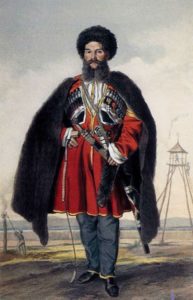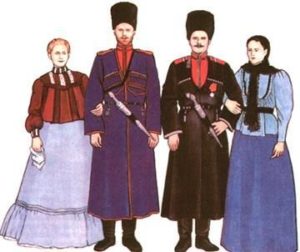The clothes of the Cossacks were practical, but at the same time they emphasized their nationality. The costumes were distinguished by their aesthetics and originality. Outfits were adapted to different times. But in any case, the clothing emphasized the connection with military affairs.
Historical reference
There were quite a lot of Cossack troops throughout Russia. The army included people of different nationalities, which was reflected in their appearance. The costume of the Don warrior combined Russian, Turkish, and Tatar outfits. Thanks to this, the costumes were bright and unusual.
The Cossack's wardrobe included a military uniform and casual attire. The Caucasian people had a great influence on clothing. Only in the middle of the 19th century was the official form approved.
Components of military clothing:
 bloomers - loose pants;
bloomers - loose pants;- papakha – fur hat;
- boots, an alternative to them were leggings;
- winter burka - sleeveless outerwear;
- Circassian coat or beshmet - caftan, outerwear;
- bashlyk - a hood that protects in bad weather.
Traditional clothing proved impractical in battle.In 1915, the caftan was replaced by a tunic. The burka was replaced by an overcoat. And the traditional hat was replaced by a comfortable cap. The old uniform was worn only on holidays.
Important! The Cossack bought uniforms, weapons and horses at his own expense. This was a mandatory part of his equipment, which was prepared long before service.
Characteristic features of a men's Cossack costume
 The traditional costume consisted of zipun, trousers, chekmen, kerei, arhaluk. There were 2 types of shirts in the wardrobe - beshmet, Russian. The first version reached to the knees, had wide sleeves, and hooks were used for fastenings. The Russian shirt was worn freely.
The traditional costume consisted of zipun, trousers, chekmen, kerei, arhaluk. There were 2 types of shirts in the wardrobe - beshmet, Russian. The first version reached to the knees, had wide sleeves, and hooks were used for fastenings. The Russian shirt was worn freely.
Important! Undershirts for the Cossacks were embroidered by wives or mothers. They were considered amulets that protected in battle. With the death of a warrior, this element of the wardrobe was burned.
In rain and frost, the Cossack wore a robe. Short fur coats, which were worn directly on the naked body, protected from frost. Burkas were also used in winter. Leather trousers, chembars, were used for fishing.
Details of men's outfits:
- stripes - colorful stripes on the sides of the trousers indicate that the Cossacks belong to a specific army, a symbol of freedom;
- earrings - the birth place was determined, so two earrings in the ear indicated the only child in the family;
- Warriors were required to wear insignia throughout their lives.
Don Cossack costume: features
The everyday outfit of a Cossack woman consisted of a shirt, skirt and jacket. On holidays, women wore a lace skirt and cuirass (short jacket). Ladies always wore an apron. If there were red clothes in the wardrobe, then they automatically became the best.
Components of a Cossack costume:
 a long shirt is the main component of the wardrobe;
a long shirt is the main component of the wardrobe;- on holidays they wore a kubelek - a dress with a V-neck and beautiful embroidery;
- married ladies sukman - a kind of sundress with short sleeves;
- outer festive outfit - kokhta;
- Everyday women wore a sundress over a shirt;
- to avoid getting dirty, they used a white apron, which was traditionally called a “zapon”;
- balls for Cossack women could be either wide or narrow;
- In winter, ladies protected themselves from the cold with a zhupeyka;
- the spidnitsa was an underskirt, which was decorated with symbolic patterns;
- in cold weather they wore a plaid skirt;
- a hood (bashlyk) was put on the hat, in which women could even carry children.
Important! The most durable outfits were made for brides. The older the women became, the darker the fabrics used for making clothes.
What is the difference between the Don Cossack costume and the Kuban one?
 The costumes of different Cossack troops had differences, depending on the location. The clothing of the Kuban Cossacks was formed under the influence of the Caucasians. Don warriors preferred Chekmeni, and Kuban warriors preferred Circassian warriors, which were popular among the highlanders.
The costumes of different Cossack troops had differences, depending on the location. The clothing of the Kuban Cossacks was formed under the influence of the Caucasians. Don warriors preferred Chekmeni, and Kuban warriors preferred Circassian warriors, which were popular among the highlanders.
On the Don they preferred trousers with stripes. In Kuban they used ordinary trousers. Everyday and on the battlefield, the Don Cossack wore a green jacket in combination with blue pants. For church, men wore red trousers. The Kuban warrior's equipment consisted of trousers, a Circassian coat and a beshmet. The color of the outfit depended on the rank and season.
Jewelry, shoes, hats, elements
 The footwear of the Cossacks and Cossack women were boots. There were quite a lot of them, because this was the most practical option. Any boots were considered soft models with a small heel or no heel at all. For sewing, bovine leather was used, which is durable.
The footwear of the Cossacks and Cossack women were boots. There were quite a lot of them, because this was the most practical option. Any boots were considered soft models with a small heel or no heel at all. For sewing, bovine leather was used, which is durable.
Over soft boots they wore leather galoshes - chiriki. In winter they wore woolen felt boots. Postals were used for work.They also wore slippers made from stiff threads and collars with fur inside.
Hats were considered an important part of the wardrobe. The men's hat was not only an element of the wardrobe, but also a part of various rituals. Cossacks wore hats, which eventually replaced caps. Women wore a scarf, a cape (bashlyk), and fabric hats.
Important! Unmarried Cossack women were allowed to walk bareheaded. But a married woman had no right to appear in society without a headscarf.
Women's jewelry consisted of chikliki and pearls. Girls could wear flat bracelets with traditional symbols, earrings, rings and rings. Gold, silver, metal, and precious stones were used for jewelry. Pearls were crushed for earrings. The material of the ring and its position on the hands determined the marital status of the Cossack woman. The festive outfit was complemented with a necklace or monisto. Wealthy ladies could afford pearl beads.


 bloomers - loose pants;
bloomers - loose pants; a long shirt is the main component of the wardrobe;
a long shirt is the main component of the wardrobe; 0
0


_7-220x175.jpg)


